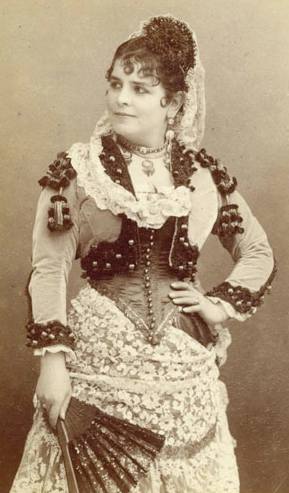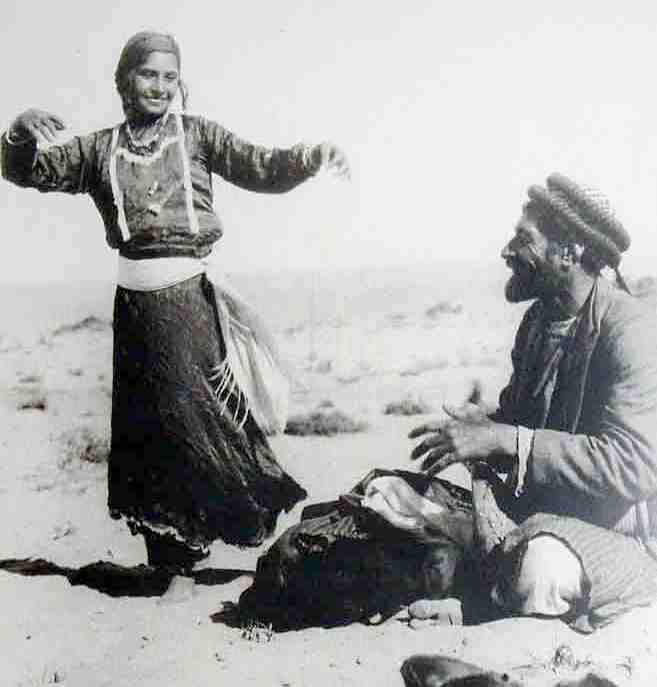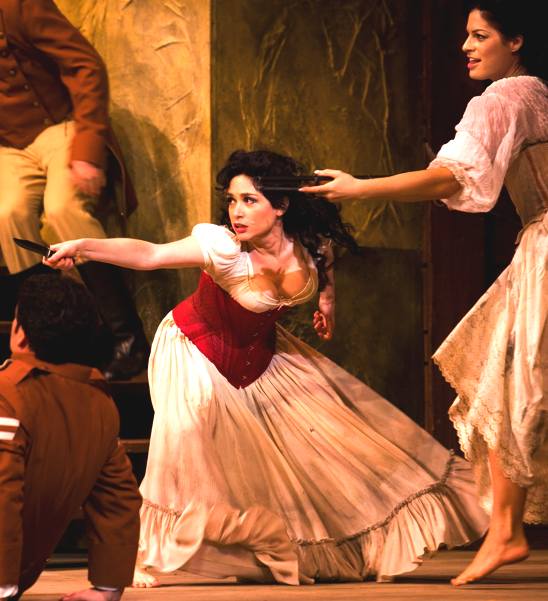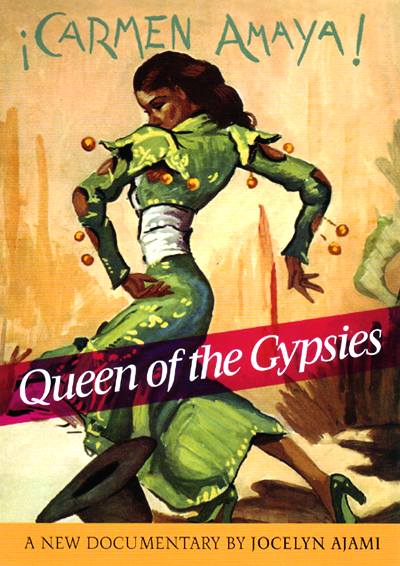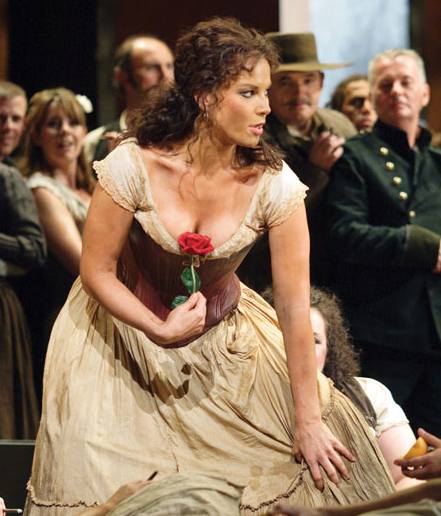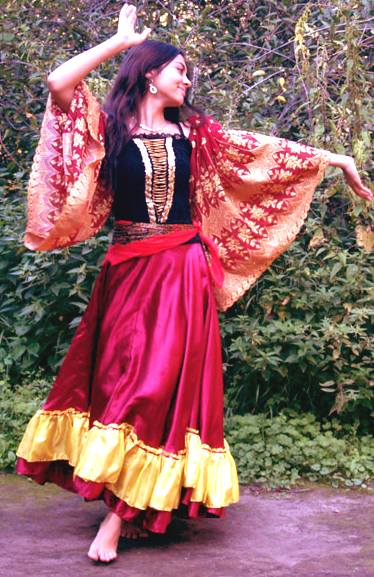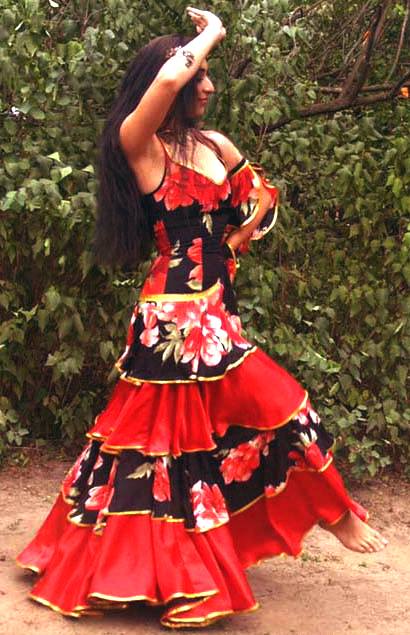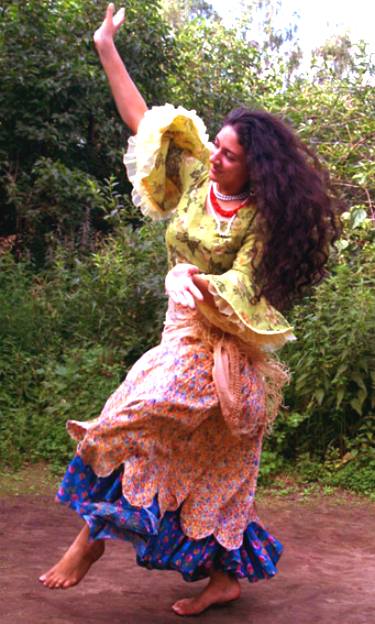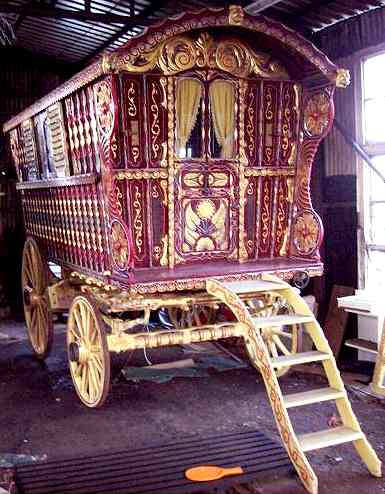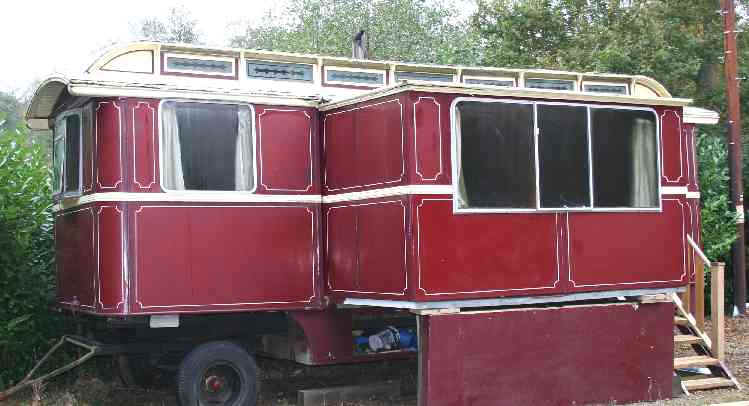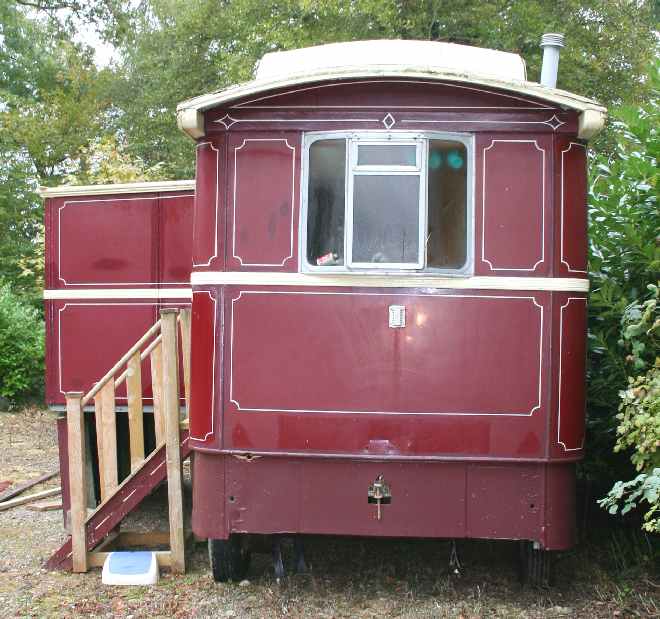|
GYPSIES
|
||||||
|
The Roma People (singular Rom; sometimes Rroma, Rrom) or Romanies, sometimes called "Romany Folk" in the United Kingdom, often referred to as Gypsies or Gipsies, are a diverse ethnic group who live primarily in Southern and Eastern Europe, Western Asia, Latin America, the United States and the Middle East. They are believed to have originated mostly from the Punjab and Rajasthan regions of India. They began their migration to Europe and North Africa via the Iranian plateau around 1050.
Traditionally most Roma spoke one of several dialects of Romani (Romany), an Indo-Aryan language. Today, however, most Roma speak the dominant language of their region of residence.
Left: Gypsy Carmen, played by Galli-Marie. Right: Gypsy dancing while camped
Population
Worldwide, there are an estimated 8 to 10 million Romanies. The largest population of Romanies is found on the Balkan peninsula; however, significant numbers also live in the Americas, the former Soviet Union, Western Europe, the Middle East, and North Africa.
The Romanies recognize divisions among themselves based in part on territorial, cultural and dialectal differences. Some authorities recognize five main groups:
Some groups, like the Finnish Romani population (Kaale) and the Norwegian and Swedish Travellers, are hard to categorize. Each of these main divisions may be further divided into two or more subgroups distinguished by occupational specialization or territorial origin, or both. Some of these group names are: Machvaya (Machwaya), Lovari, Churari, Rudari, Boyash, Ludar, Luri, Xoraxai, Ungaritza, Bashaldé, Ursari and Romungro.
History
Linguistic and genetic evidence indicates the Roma originated on the Indian Subcontinent[6]. The cause of the Roma diaspora is unknown. One theory suggests the Roma were originally low-caste Hindus recruited into an army of mercenaries, granted warrior caste status, and sent westwards to resist Islamic military expansion. Or perhaps the Muslim conquerors of northern India took the Roma as slaves and brought them home, where they became a distinct community; Mahmud of Ghazni reportedly took 500,000 prisoners during a Turkish/Persian invasion of Sindh and Punjab. Why the Roma did not return to India, choosing instead to travel west into Europe, is an enigma, but may relate to military service under the Muslims.
Contemporary scholars have suggested that one of the first written references to the Roma, under the term "Atsinganoi", (Greek), dates from the Byzantine era during a time of famine in the 9th century. In the year 800 A.D., Saint Athanasia gave food to "foreigners called the Atsinganoi" near Thrace. Later, in 803 A.D., Theophanes the Confessor wrote that Emperor Nikephoros I had the help of the "Atsinganoi" to put down a riot with their "knowledge of magic".
"Atsingani" was used to refer to itinerant fortune tellers, ventriloquists and wizards who visited the Emperor Constantine IX in the year 1054. The hagiographical text, The Life of St. George the Anchorite, mentions that the "Atsingani" were called on by Constantine to help rid his forests of the wild animals which were killing off his livestock. They are later described as sorcerers and evildoers and accused of trying to poison the Emperor's favorite hound.
BIZET'S OPERA - Carmen is a gypsy woman working in a tobacco factory. Gypsies are mysterious, mischievous, and mystical. Their dance form and spectacular dresses is both seductive and enchanting. Elīna Garanča is the stunning gypsy in award-winning director Richard Eyre's production of Carmen. One of the most popular operas of all time, Carmen "is about sex, violence, and racism. Bizet's drama. "It is one of the inalienably great works of art. It's sexy, in every sense and shocking." Elīna Garanča sings the seductive gypsy for the obsessed Don José.
In 1322 a Franciscan monk named Simon Simeonis described people resembling these "atsinganoi" living in Crete and in 1350 Ludolphus of Sudheim mentioned a similar people with a unique language whom he called Mandapolos, a word which some theorize was possibly derived from the Greek word mantes (meaning prophet or fortune teller).
Around 1360, an independent Romani fiefdom (called the Feudum Acinganorum) was established in Corfu and became "a settled community and an important and established part of the economy."
By the 14th century, the Roma had reached the Balkans; by 1424, Germany; and by the 16th century, Scotland and Sweden. Some Roma migrated from Persia through North Africa, reaching Europe via Spain in the 15th century. The two currents met in France. Roma began immigrating to the United States in colonial times, with small groups in Virginia and French Louisiana. Larger-scale immigration began in the 1860s, with groups of Romnichal from Britain. The largest number immigrated in the early 1900s, mainly from the Vlax group of Kalderash. Many Roma also settled in Latin America.
Wherever they arrived in Europe, curiosity was soon followed by hostility and xenophobia. Roma were enslaved for five centuries in Romania until abolition in 1864. Elsewhere in Europe, they were subject to ethnic cleansing, abduction of their children, and forced labor. During World War II, the Nazis murdered 200,000 to 800,000 Roma in an attempted genocide known as the Porajmos. Like the Jews, they were sentenced to forced labour and imprisonment in concentration camps. They were often killed on sight, especially by the Einsatzgruppen (mobile killing units) on the Eastern Front.
In Communist Eastern Europe, Roma experienced assimilation schemes and restrictions of cultural freedom. The Romani language and Roma music were banned from public performance in Bulgaria. In Czechoslovakia, they were labeled a "socially degraded stratum," and Roma women were sterilized as part of a state policy to reduce their population. This policy was implemented with large financial incentives, threats of denying future social welfare payments, misinformation, and involuntary sterilization (Silverman 1995; Helsinki Watch 1991). In the early 1990s, Germany deported tens of thousands of illegal immigrants to Eastern Europe. Sixty percent of some 100,000 Romanian nationals deported under a 1992 treaty were Roma.
Society and culture
The traditional Roma place a high value on the extended family. Virginity is essential in unmarried women. Both men and women often marry young; there has been controversy in several countries over the Roma practice of child marriage. Roma law establishes that the man’s family must pay a dower to the bride's parents.
Roma social behaviour is strictly regulated by purity laws ("marime" or "marhime"), still respected by most Roma and among Sinti groups by the older generations. This regulation affects many aspects of life, and is applied to actions, people and things: parts of the human body are considered impure: the genital organs, because they produce impure emissions, and the lower body. Fingernails and toenails must be filed with an emery board, as cutting them with a clipper is taboo. Clothes for the lower body, as well as the clothes of menstruating women are washed separately. Items used for eating are also washed in a different place. Childbirth is considered impure, and must occur outside the dwelling place. The mother is considered impure for forty days. Death is considered impure, and affects the whole family of the dead, who remain impure for a period of time. Many of these practices are also present in cultures such as the Balinese. However, in contrast to the practice of cremating the dead, Roma dead must be buried. It is possible that this tradition was adapted from Abrahamic religions after the Roma left the Indian subcontinent.
PLANNING IN THE UK
Debate
The
discourse about Gypsy and Traveller communities has a long and
well-established history. An integral element has been the unresolved
tension between the experiences of Traveller and settled communities,
and the relationship between these communities and the state. These
experiences are replicated across England and Wales, with recent media
attention focused on examples in Bournemouth, Bedfordshire,
Gloucestershire, Monmouthshire and the London Borough of Newham. The
Office of the Deputy Prime Minister (ODPM) is currently consulting on
strategies for managing unauthorised encampments, and the Department of
the Environment, Food and Rural Affairs (DEFRA) has just published
proposals for the regulation and governance of public spaces. The
implementation of the new duties on public bodies to promote community
relations and race equality under the Race Relations Amendment Act in
May 2002 will also have a bearing on the delivery of goods and services
to the Gypsy and Traveller communities.
The Main Issues
the needs, experiences and rights of Gypsy and Traveller communities, particularly in relation to accommodation and economic activity, on the one hand, and
History
Gypsies have been travelling the roads of Britain for hundreds of years, but now only one in 10 Romanies spend their lives on the move. Hannah Satterthwaite talks to John and Linda Porter about what the future holds for their community.
By the age of nine John Porter was at work with his father, collecting scrap and doing odd jobs. He was married to his childhood sweetheart at 14, by which time the family had relocated more times than he can remember. Born in a Gypsy wagon in the tiny village of Newton in the Willows in Lincolnshire, John’s childhood is not unusual for a Romany traveller. “We had to start work young,” he said. “That was the only way to survive. We started as kids and never stopped.”
Traditional Gypsy Caravans
More
Gypsy Voices
Gypsies are thought to have arrived on English soil about 400 years ago. Researchers believe they left the Indus valley in northern India in the ninth century and travelled through Persia, reaching eastern Europe about 1,000 years ago. Their language contains Sanskrit, along with parts of the Greek, Romanian and other languages. They have historically moved around the UK, taking up seasonal work such as fruit- and flower-picking. Travellers say one of the main reasons for conflict between their community and the sedentary one is that British society does not recognise the right to a nomadic way of life.
Many non-Gypsies know little more about Gypsy culture than quaintly painted wagons and women who wear large gold-hooped earrings - although many Gypsies have neither. Although there are an estimated 42,000 Gypsy traveller children in England, they have been very much a poor relation in terms of receiving specialist support in schools and in terms of the recognition of their culture within the curriculum. As long ago as 1967, the Plowden reports acknowledged the specific needs of Gypsy traveller children, stating that: "the children's educational needs are . . . extreme and largely unmet . . . They will require special attention and carefully planned action."
HMI reports in 1996 and 1999 raised concerns about the level of attainment of Gypsy traveller pupils, particularly at secondary school level, where attendance rates are lower than at primary school. "In all schools where information was available, over 50% of the Gypsy traveller population were on the SEN [special educational needs] register, and in one school it was 80%. In half the schools, no Gypsy traveller child has yet sat for GCSE," says the 1999 HMI report, Raising the Achievement of Minority Ethnic Pupils.
Voices: The Gypsy's Horse is on Radio 4 at 11.30pm on Friday August 22. The Voices website is at www.bbc.co.uk/kent/voices/ Aiming high: raising the achievement of gypsy traveller pupils - a guide to good practice is available by emailing dfes@prolog.uk.com or calling 0845 6022260.
Drawing showing traditional
LINKS and REFERENCE
http://gypsyheartproductions.com http://english.svenko.net/dance/ http://www.presidencia.gov.br/seppir/informativos/not/001.htm 313,000 self-declared in 1992 census (Elena Marushiakova and Vesselin Popov, The Gypsies of Bulgaria: Problems of the Multicultural Museum Exhibition (1995), cited in Patrin Web Journal); 450,000 estimated in 1990 (U.S. Library of Congress study); at least 553,466 cited in a confidential census by the Ministry of the Interior in 1992 (cf Marushiakova and Popov 1995). 750,000 ±50,000 is Marushiakova and Popov's 1995 estimate. 9,463 according to the 2001 census. 12,000 according to 2001 census 220,000 according to NGOs ([1]). 1980s estimate of 500,000 from U.S. Library of Congress Country study. http://www.domresearchcenter.com/population/popiran.html Early 1990s from U.S. Library of Congress Country study. People on the Move - Supp. N°93, Pontifical Council, December 2003, pp.299-305. 2002 census data, based on Population by ethnicity figures. Independent estimates range from 1 to 2 million (World Bank, International Association for Official Statistics). 2002 Russian census recorded 182,766 Roma (gypsies). Independent estimates range from 5 to 6 million 2002 census not including Kosovo. Independent estimates range between 400,000 and 800,000 (including Kosovo) U.S. Library of Congress Country study. No official count; estimate from Reaching the Romanlar - A Feasibility Study Report (International Romani Studies Network), Istanbul: 2006, p.13. See also Turkey: A Minority Policy of Systematic Negation (IHF report) and SERİN, Ayten (08.05.2005). AB ülkeleriyle ortak bir noktamız daha ÇİNGENELER. Hürriyet. Retrieved on September 23, 2006. 40,000 estimated Romani speakers, mainly immigrants from Eastern Europe. Accurate figures for non-Romani-speaking Roma not known. See also http://www.llc.manchester.ac.uk/Research/Projects/romani/Matras 2001 Ukrainian census recorded 47,587 Roma (gypsies). Kenrick Donald. Historical Dictionary of the Gypsies (Romanies). Scarecrow Press, 1998. ISBN 0-8108-3444-8 A Chronology of significant dates in Romani history http://www.geocities.com/Paris/5121/death.htm http://www.eyeonnortherneurope.com/news_20040407.php Roma (Gypsies) in the Byzantine empire Women’s reproductive right to family life interferance by Health Minister (Bulgaria) "Gypsies: The Usual Suspects," by Hector Becerra, Los Angeles Times, Jan 30, 2006. [5] Achim, Viorel (2004). "The Roma in Romanian History." Budapest: Central European University Press. ISBN 963-9241-84-9. Auzias, Claire. Les funambules de l'histoire. Baye: Éditions la Digitale, 2002. De Soto, Hermine. Roma and Egyptians in Albania : From Social Exclusion to Social Inclusion. Washington, DC, USA: World Bank Publications, 2005. Fonseca, Isabel. Bury me standing : the Gypsies and their journey. New York: A.A. Knopf, 1995. Fraser, Angus The Gypsies : Blackwell Publishers, Oxford UK, 1992 ISBN 0-631-15967-3. Genner, Michael. Spartakus, 2 vols. Munich: Trikont, 1979-80. “Germany Reaches Deal to Deport Thousands of Gypsies to Romania,” Migration World Magazine, Nov-Dec 1992. Gray, RD; Atkinson, QD (2003). "Language-tree divergence times support the Anatolian theory of Indo-European origin." Nature. Gresham, D; et al. (2001). "Origins and divergence of the Roma (Gypsies)." American Journal of Human Genetics. 69(6), 1314-1331. [12] Hackl, Erich. (1991). Farewell Sidonia, New York: Fromm International Pub. ISBN 0-88064-124-X. (Translated from the German, Abschied von Sidonie 1989) Helsinki Watch. Struggling for Ethnic Identity: Czechoslovakia’s Endangered Gypsies. New York, 1991. Leland, Charles G. The English Gipsies and Their Language. London: Trübner & Co., 1873. Lemon, Alaina (2000). Between Two Fires: Gypsy Performance and Romani Memory from Pushkin to Post-Socialism. Durham: Duke University Press. ISBN 0-8223-2456-3 Luba Kalaydjieva; et al. (2001). "Patterns of inter- and intra-group genetic diversity in the Vlax Roma as revealed by Y chromosome and mitochondrial DNA lineages." European Journal of Human Genetics. 9, 97-104. [13] Marushiakova, Elena; Popov, Vesselin. (2001) "Gypsies in the Ottoman Empire." Hatfield: University of Hertfordshire Press. McDowell, Bart (1970). "Gypsies, Wanderers of the World". National Geographic Society. ISBN 0-87044-088-8. "Gypsies, The World's Outsiders." National Geographic, April 2001, 72-101. Ringold, Dena. Roma & the Transition in Central & Eastern Europe : Trends & Challenges. Washington, DC, USA: World Bank, 2000. pg. 3,5, & 7. Roberts, Samuel. The Gypsies: Their Origin, Continuance, and Destination. London: Longman, 4th edition, 1842. Silverman, Carol. “Persecution and Politicization: Roma (Gypsies) of Eastern Europe.” Cultural Survival Quarterly, Summer 1995. Simson, Walter. History of the Gipsies. London: S. Low, 1865. Tebbutt, Susan (Ed., 1998) Sinti and Roma in German-speaking Society and Literature. Oxford: Berghahn. Turner, Ralph L. (1926) The Position of Romani in Indo-Aryan. In: Journal of the Gypsy Lore Society 3rd Ser. 5/4, pp. 145–188. Danish Broadcasting Corporation A page in Danish about Roma treatment in Denmark Firdawsi Tousi. “Shah-Nameh” (book of Kings) ca. 1000 A.D. Accessing Council Services and Information The Disability Discrimination Act Equality and Diversity, Black Minority Ethnic Community Contact List ypsies ,Travellers and Unauthorised Camping History Of English Gypsy Traveller Racist Incidents and Hate Crime Race Relations (Amendment) Act 2000 (RRAA) Gypsy leader charges dropped 15 Apr 03 | North Yorkshire Gypsies say council is racist 04 Apr 03 | England Award for gypsy leader 24 Mar 03 | England Legal action to remove gypsies delayed 19 Mar 03 | England Gypsy leader gets UN role 18 Jan 03 | England Gypsy
Collections - Gypsy wagons Gipsy
Caravan Horse
Drawn Gypsy Caravans Holidays, Building and Restoration Gypsy-Vardo.com
- Restoring a Gypsy Vardo Caravan Gypsy
wagon traveller for sale Gypsy
Caravan Building, Restoration and Painting Horse
Drawn Gypsy Caravan Holidays, Wiltshire Gypsy-Vardo.com
- Restoring a Gypsy Vardo Caravan BBC
NEWS | Wales | Mid Wales | Respects paid as caravan burns The
Observer | Special reports | A burning issue in the village http://www.bltm/epona/index.htm Build your own wagon - project story and pictures. http://english.svenko.net/dance/
Traditional Gypsy Caravan - pull out center extended
Gypsies enjoy special freedoms in freedom to roam and set up home planning wise. Pictures of this beautiful collectible can be found on the Speedace web site index page - under Caravan, Gypsy Wagon. Delivery to be arranged subject to clearance of funds.
Many of the services listed in our A-Z offer you the chance to enjoy the flavour of these traditional tents at your wedding reception or corporate event. Once you have decided on the theme you'd prefer, please speak with our event organiser, to arrange your booking. See the contacts links above.
|
||||||
|
This website is Copyright © 2013 Kismet Girls Trust. All rights reserved. All other trademarks are hereby acknowledged. |
